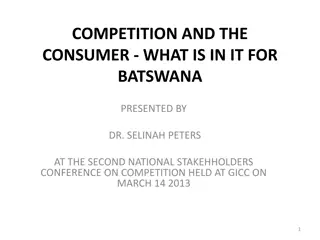Understanding Consumer Behavior: Importance and Application
Concept of consumer behavior and its impact on various aspects of business, including sales, pricing, promotion, competitive analysis, forecasting, targeting, segmentation, and product portfolio design.
- consumer behavior
- sales
- pricing
- promotion
- competitive analysis
- forecasting
- targeting
- segmentation
- product portfolio
Download Presentation

Please find below an Image/Link to download the presentation.
The content on the website is provided AS IS for your information and personal use only. It may not be sold, licensed, or shared on other websites without obtaining consent from the author. Download presentation by click this link. If you encounter any issues during the download, it is possible that the publisher has removed the file from their server.
E N D
Presentation Transcript
Presented by Dr. U. JAHIR HUSSAIN Assistant Professor of Commerce Jamal Mohamed College (Autonomous) Tiruchirappalli - 620 020.
Consumer behaviour simply means how consumers behave in the market. It defines the way in which consumers purchase products & services for satisfying their wants. It basically consists of likes & dislikes of customers which influence his decision while purchasing products.
1. Increase Sales 2. Setting Prices 3. Sales Promotion 4. Helps in Competitive Analysis 5. Helps in Forecasting 6. Targeting & Segmentation 7. Designing Product Portfolio
1. Increase Sales: Business will offer the right product to its customers. Customers will become loyal if getting the right product. This will increase sales & revenue for business. 2. Setting Prices: Setting prices is one of the important & difficult task for any business. It directly influences the demand for its products in the market. By understanding consumer behaviour, it becomes easy to determine whether the customer is price concerned or quality concerned. 3. Designing Sales Promotion Methods: Sales promotion activities are the different methods used for inducing customers to buy a product. Promotion activities are effective if they present clearly the features of the product as per customer needs.
4. Helps In Competitive Analysis: Understanding their behaviour helps in analysing the reasons for which they are going for competitors products. It helps in understanding the advantages that competitors are possessing. This help in facing the competition in a better way. 5. Helps In Forecasting: Forecasting helps in taking competitive advantages from the businesses. If the business is able to forecast about the future it can easily take several advantages. Consumer behaviour enables the businesses in easy forecasting of sales & demand forecasting. 6. Helps In Targeting & Segmentation: Segmentation & Targeting helps in serving customers properly. It segments the customers according to their taste & class. Segmentation helps in serving the customer better. It helps businesses to focus on customers as per their needs. 7. Helps In Designing Product Portfolio: Product portfolio refers to a set of different products offered by businesses. Every business product portfolio must consist of all class of products. It should have products for all class of peoples in the market. Understanding customer behaviour helps the businesses in easy understanding demand of market. This will help in proper designing of product portfolio for the businesses.
Definitions Classification Importance Main Types of Motives for Buying Knowledge and Difficulties
In the words of D. J. Durdian, Buying motives are those influences or considerations which provide the impulse to buy, induce action or determine choice in the purchase of goods and services. According to Dr. R.S. Davar A motive is defined as an inner urge that moves or prompts a person to action. It is clear from the above definitions of buying motives that buying motive is meant for the powers that inspire any person to buy the goods or items.
1. Physical Buying Motives 2. Psychological Buying Motives 3. Sociological Buying Motives 4. Acquired Buying Motives 5. Inherent Buying Motives
6. Primary Buying Motives 7. Selective Buying Motives 8. Conscious Buying Motives 9. Dormant Buying Motives 10.Product Buying Motives 11. Patronage Buying Motives
1. Physical Buying Motives: buying motives are related to the satisfaction of basic human needs for subsistence such as satisfaction of the needs for food, shelter and clothes, and security. 2. Psychological Buying psychological buying motives relates to the need for prestige or self-preservation, etc. 3. Sociological Buying Motives: The sociological buying motives are related to the motives that exist at present and is expected in all the social situations. The psychological Motives: The
4. Acquired Buying Motives: The acquired buying motives are learned motives and are influenced by the environment factors. Such motives are related to socioeconomic conditions and the level of education, such as economy, information, work efficiency, profit facility, quality, beauty, acceptance, etc. 5. Inherent Buying Motives: The inherent buying motives are present in a person from his birth. It belongs to basic human instincts whereas the acquired buying motives are concerned with the environment. They are influenced by hunger, thirsts, sleep, leisure, security, playing entertainment, etc. fashion, social presage,
6. Primary Buying Motives: The primary buying motives increase the general demands for products and not the specific demands for a specified product/brand. The demands for radios, TVs, cars, motorcycles, etc. fall under this category of primary motives. 7. Selective Buying Motives: The selective buying motives influence for the purchase of specific brands, for instance, the demands for Bajaj s Chetak Scooter, Onida TV, Philips Radios, etc.
8. Conscious Buying Motives: The conscious buying motives are such motives, which are identified by the buyer without any help from marketing functions, like advertising, personal selling or promotional tools. The conscious buying motives influence the satisfaction of presently existing needs of a customer. Such buying motives take shape within the sub-conscious minds of the customers and are not influenced by the external environmental factors. 9. Dormant Buying Motives: motives are silent motives and do not influence the buyers until their attention is invited by the marketing functions. Thus, dormant buying motives are related with satisfaction of those needs which are created by the marketing functions. A consumer does not possess the knowledge of such needs without the persuasion of marketing activities. The dormant buying
10. Product Buying Motives: Product buying motives motivates a person towards purchasing a special products. This motive is a generated by the physical and psychological features of the product, such as design, colour, size, package, quality, price etc. 11. Patronage Buying Motives: Patronage motive influences a person to purchase the products of a specific seller, dealer or a producer. If a customer is satisfied with the product of a specific seller/producer, he prefers to buy the products of that seller/producer because of certain advantages, such as home delivery of goods purchased, a reasonable price, location of the seller/shop, assortment of goods, goodwill demonstration of the product and decoration of the shop, and the good behaviour of the seller.
Success of Salesmanship Facilitates Product Planning Facilitates Pricing of Product Facilitates to Produce Promotional Material Facilitates the Selection of Distribution Channels Creation of Goodwill Efforts to make change in Buying Motives
1. Success of salesmanship A salesman can achieve success by knowing more about the buying motives of customers. On the basic knowledge of buying motives, the salesman will be able to make available the goods and services to the customer s choice in price, quality and other specifications. This way, the customers are satisfied in a short period of time. 2. Facilitates product planning Knowledge about the buying motives of customers facilitates product planning, by way of using appropriate colour, design, size, package, price, etc. to the product in accordance with consumer preference. 3. Facilitates pricing of product Knowledge about the buyer motives also is helpful in pricing the product. Emotion oriented customer may be prepared to pay a higher price, whereas knowledgeable customer will be prepared to pay a reasonable price, only.
4. Facilitates to produce promotional material Every sales organization makes efforts through promotional methods, such as advertising, sales promotion, personal selling and publicity to increases its sales. By having the knowledge of buying motives of customers, the marketing manager will be able to select appropriate promotional tools, so as to induce his customers more effectively. 5. Facilitates the selection of distribution channels Many customers are influenced by self-protective buying motives and they like to purchase products from the wholesalers. This may be due to the facilities extended by the middlemen to their customers. In such a situation, the producer has to consider the buying motives of customers, before deciding the appropriate channels of distribution. 6. Creation of goodwill Any seller or a trader can satisfy the customers by learning their habits. The customers create brand loyalty towards the products of certain producers. It is the consumer behaviour that creates goodwill of the firm and its products. 7. Efforts to make change in buying motives Efforts can be made by learning from the buying motives of a customer, to bring changes in his motives. If the behaviour of the seller is very good, certain customers may like to purchase goods from that seller only.
Utility Health Fear Comfort and Convenience Desire for Money Sex Love or Affection Possession Pride Curiosity Fashion
1. Utility: Every person wants to acquire maximum utility from the limited income. A knowledge pertaining to buying motives of utility is therefore, must for a seller. 2. Fear: Fear is a negative motive and it is powerful. Fear is of different forms.Fear assists selling any of the items. A seller should adopt the strategies of sales promotion, advertisement etc. after proper study on the motives related to the fear. 3. Desire for Money: Almost all persons are motivated to earn money and do saving. It is the reason that every producer intends earning maximum profit by reducing cost. It is sole desire to earn money which has made busy to traders, producers, salaried class etc., throughout the day and night. A seller having this desire can only earn the profits.
4. Love or Affection: Every person is influenced by the feeling of love and affection. Owing to the motive of love and affection, the person buys several goods. 5. Pride: Some persons are found proudly. Feeling of envy is largely found in the women. Every person prefers listening his false praise. On having satisfied the ego feeling, the buyer concerned becomes ready to pay more price for the goods. A seller therefore, should well known to the pride motive. 6. Fashion: Today s age is the age of fashion. Every buyer does efforts to buy the goods popular at a particular period of time. Fashion is the desire that follows other people. Every person wants to come forward in race of fashion being run now-a-days. An efficient seller should therefore, conversant to this motive too. 7. Health: Every person tries to make himself healthy. This motive relating to the health inspires the man for buying the items. For examples, vitamin tablets, a good diet and tonic etc. In the context of children, this motive is more important.
8. Comfort and Convenience: Every person wants to live a life in comfort and convenience. Owing to this motive, the people purchase the items relating to the comfort and luxuries. For example, fans, washing machines, scooters, coolers and car etc. 9. Sex: A seller is required to engage himself regarding the buying motives for the items related to the sex. The motive of buying relating to the sex contributes to a large extent in the sale of a number of items. The style of fashion may be ceased if there is lack of buying motive for sex.The man and women buy several items with an objective to attract one another. 10. Possession: Every person has a usual tendency to keep the things under his possession. This motive inspires him to buy several things like a building, automobile etc. 11. Curiosity: Curiosity is a prominent motive and it is the curiosity that motivates a number of tourists to visit and see the places of interest and it makes possible the new intentions too. The buyers under this motive buy a number of things daily. By awaking the curiosity among readers, several publishers are publishing the novels, stories and plays now-a-days.
1. Knowledge of Buying Motives by Salesman: The seller who is so sensitive as to grasp the buying motives of a buyer on a slight conversation can only be a successful buyer today. After getting the smell of motive in the buyer, he sells the concerned goods to him. A salesman can obtain the knowledge of buying motive by virtue of application of following methods: (i) By Interrogating the Buyers (ii) Through Observation (iii) Knowledge Regarding the Objective of the Buyers (v) Motivational Research (iv) Use of Visual Means
2. Knowledge of Buying Motives by Manufacturers: As the producers and manufacturers cannot make their direct contact with the consumers and the buyers, they have to take help from motivational research in order to get information of the group or common or the representative buying motives. Motivational research and surveys are in vogue now-a-days. The conclusions arrived through them are being proved beneficial for the manufacturers.

























